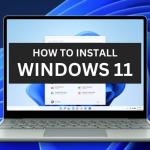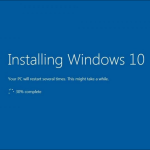How to Install or Downgrade to Windows 10 on Any PC
Looking to install a clean version of Windows 10 on your PC or downgrade from Windows 11? Whether you're setting up a new computer, switching operating systems, or just prefer the stability of Windows 10, the process is straightforward with the right tools.
Unfortunately, there’s no direct downgrade path from Windows 11 to Windows 10—you’ll need to perform a clean installation using a USB flash drive or installation disc. However, if you're upgrading from older versions like Windows 7 or Windows 8.1, the process is much simpler and doesn’t require external media.
In this step-by-step guide, we’ll show you how to install or upgrade to Windows 10 on any PC—whether you're using Windows 11, another operating system, or starting from scratch.
Table of contents [Show]
- PART 1 Creating an Installation Disc or Drive
- Step 1: Prepare a Bootable USB or DVD for Windows 10 Installation
- Step 2: Ensure You Have a Valid Windows 10 Product Key or Digital License
- Step 3: Visit the Official Windows 10 Download Page
- Step 4: Download the Media Creation Tool
- Step 5: Run the Media Creation Tool
- Step 6: Accept the License Terms
- Step 7: Choose Installation Media or Upgrade Option
- Step 8: Choose Language, Edition, and Architecture
- Step 9: Select Installation Media Type
- Step 10: Create Your Windows 10 Installation Media
- PART 2 Booting from Windows 10 Installation Media
PART 1 Creating an Installation Disc or Drive
Step 1: Prepare a Bootable USB or DVD for Windows 10 Installation
To install Windows 10, you'll first need to create bootable installation media using either a blank USB flash drive or a writable DVD. Here’s what you’ll need:
USB flash drive (minimum 8GB) — Make sure it’s empty, as all data will be erased.
Blank writable DVD — Optional, but useful if your PC doesn’t support USB booting.
💡 Tip: If your PC already has Windows 10 and you're just looking to reinstall it, the easiest way is to do it directly from within the current Windows 10 installation—no need for a bootable drive or disc.
If you're upgrading from Windows 7 or Windows 8.1, you don't need to create bootable media. However, you'll still need to follow similar steps to begin the upgrade process.
Step 2: Ensure You Have a Valid Windows 10 Product Key or Digital License
Before installing or reinstalling Windows 10, it’s important to confirm your product key or digital license:
💡 Purchased from Microsoft?
If you bought Windows 10 directly from Microsoft while signed in with your Microsoft account, your product key is automatically linked to your account—no need to enter it manually.
💡 Bought from a retailer?
You should have received a 25-character product key. Keep this key handy, as you'll need it during or after installation to activate Windows.
🔐 No product key? Using a new hard drive?
Make sure your Windows 10 digital license is linked to your Microsoft account before starting.
Navigate to:
Settings > Update & Security > Activation
If it says "Windows is activated with a digital license", click Add an account and follow the prompts to link your Microsoft account.
🆓 Upgrading from Windows 7 or 8.1?
If your PC is eligible for a free upgrade, you won’t need a product key—Windows 10 will activate automatically after installation.
Step 3: Visit the Official Windows 10 Download Page
Head over to the official Microsoft website to download the Windows 10 installation tool:
👉 https://www.microsoft.com/en-us/software-download/windows10
This is the official and safest source for downloading Windows 10. From here, you can create installation media or upgrade your PC directly.
Step 4: Download the Media Creation Tool
On the Windows 10 download page, click the blue "Download tool now" button located in the middle of the screen. This will download the Media Creation Tool, which is essential for:
Creating a bootable USB flash drive or DVD for clean installation
Starting a direct upgrade to Windows 10 from a previous version
✅ Using the official tool ensures you're installing the latest, most secure version of Windows 10.
Step 5: Run the Media Creation Tool
Once the Media Creation Tool has finished downloading, navigate to your Downloads folder (or wherever your browser saves files by default).
Locate the file named something like MediaCreationToolXXXX.exe (the numbers may vary based on version).
Double-click the file to launch the tool.
When prompted by Windows, click "Yes" to allow the installer to run.
💡 Running this tool gives you access to create installation media or begin a direct upgrade to Windows 10.
Step 6: Accept the License Terms
After launching the Media Creation Tool, you'll see the Microsoft Software License Terms window.
Review the terms if you'd like.
Then, click the "Accept" button located in the bottom-right corner to proceed.
✅ Accepting the license agreement is required to continue with the installation or media creation process.
Step 7: Choose Installation Media or Upgrade Option
When prompted, select the option that best suits your needs:
✅ Create installation media (USB flash drive, DVD, or ISO file) for another PC
Select this option if you want to create a bootable USB or DVD that can be used to install Windows 10 on any compatible device, not just your current computer. Then click Next to continue.
🔄 Upgrade this PC now
Choose this option if you're upgrading your current PC from an older version like Windows 7 or Windows 8.1.
Follow the on-screen instructions, and Windows 10 will be installed directly.
🎉 No need for installation media—you're done!
💡 Tip: Creating installation media gives you more flexibility if you plan to install Windows 10 on multiple devices.
Step 8: Choose Language, Edition, and Architecture
Next, you'll be prompted to select your Windows 10 setup preferences:
🌐 Language – Choose your preferred language.
🖥️ Edition – Make sure to select the Windows 10 edition that matches your license (e.g., Home, Pro).
🧠 Architecture – Choose between 64-bit, 32-bit, or Both:
Use 64-bit if you're installing on a modern PC (most common).
Use 32-bit for older hardware.
Select Both if you're unsure or plan to install on multiple types of devices.
If you're installing Windows 10 on the current PC, the tool will auto-select the recommended settings. Simply review them and click Next to proceed.
💡 Tip: Make sure the selected options match the PC you're going to install Windows 10 on—this ensures compatibility and proper activation.
Step 9: Select Installation Media Type
Now, choose how you want to create your Windows 10 installation media:
💾 USB Flash Drive – Recommended for most users.
Select this if you have a blank USB drive with at least 8GB of storage. The tool will automatically create a bootable drive for you.
💿 ISO File – Choose this option if you plan to burn the installation files to a DVD later. The tool will save the ISO file to your PC, which you can then write to a disc using DVD-burning software.
After selecting your preferred installation type, click Next to continue.
🔍 Tip: For ease of use and faster installation, the USB flash drive option is usually the best choice—especially for newer computers.
Step 10: Create Your Windows 10 Installation Media
The process varies slightly depending on whether you're using a USB flash drive or ISO file (DVD):
🔌 For USB Flash Drive:
Select your USB drive from the list of available devices.
Click Next to begin copying the Windows 10 installation files.
Wait for the process to complete—this may take a few minutes.
Once finished, click Finish. Your bootable USB drive is now ready to use.
💿 For ISO File (DVD):
Click Save to download the ISO file to your computer.
Note: The file is large, so download time will vary based on your internet speed.
A progress bar will display during the download.
Once complete, click Open DVD burner on the "Burn the ISO file to a DVD" screen.
Insert a blank DVD, select your DVD burner, then click Burn to create your Windows 10 installation disc.
✅ Tip: Using a USB flash drive is typically faster and more convenient than burning a DVD.
PART 2 Booting from Windows 10 Installation Media
Step 11: Connect Your Windows 10 Installation Media
Now that your installation media is ready, it's time to use it on the PC where you want to install Windows 10:
💾 Using a USB Flash Drive?
Plug the bootable USB drive into a USB port on the target computer.
💿 Using a DVD?
Insert the Windows 10 installation DVD into the DVD drive of the PC.
💡 Tip: Make sure the PC is powered off before inserting the installation media. You’ll boot from the media in the next step to start the installation process.
Step 12: Access the BIOS or UEFI to Change Boot Order
To install Windows 10 from your USB drive or DVD, your PC must be set to boot from the installation media. If it’s not already configured this way, you’ll need to change the boot order in your system’s BIOS or UEFI settings.
🛠️ How to Enter BIOS/UEFI Settings:
If you're running Windows 10 or Windows 8.1:
Open Settings.
Go to Update & Security > Recovery.
Under Advanced startup, click Restart now.
Navigate to Troubleshoot > Advanced Options > UEFI Firmware Settings, then click Restart.
For any PC (including older systems):
Restart your computer.
Immediately press the BIOS key repeatedly during startup (as soon as the screen turns on).
Here are common BIOS/UEFI keys by manufacturer:
| Manufacturer | BIOS/UEFI Key(s) |
| Acer / Asus | F2 |
| Dell | F2 or F12 |
| HP | Esc or F10 |
| Lenovo | F1, F2, or Fn + F2 |
| Lenovo ThinkPad | Enter, then F1 |
| MSI | Del |
| Microsoft Surface | Press and hold Volume Up |
| Samsung / Toshiba | F2 |
| Sony | F1, F2, or F3 |
💡 Tip: If you're unsure, check your PC’s manual or manufacturer’s support page for the correct key.
Once you're inside the BIOS/UEFI settings, you’ll need to adjust the boot order so your PC starts from the USB drive or DVD.
Use the arrow keys on your keyboard to navigate to the Boot tab.
Depending on your PC manufacturer, this tab may be labeled Boot Options, Boot Menu, or Boot Order.
Locate the section that lists your bootable devices (e.g., USB drive, DVD drive, hard disk).
🧭 Tip: If you’re using a UEFI interface with mouse support, you may be able to click instead of using arrow keys.
 ไทย
ไทย  中文 (香港)
中文 (香港)  中文 (中国)
中文 (中国)  中文 (台灣)
中文 (台灣)  ພາສາລາວ
ພາສາລາວ 



